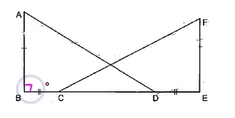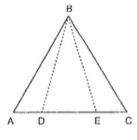In Figure, DEBC, if AD=x,DB=x−2,AE=x+2 and EC=x−1, find the value of x.
To solve the problem, we will use the properties of similar triangles since DE is parallel to BC. This gives us the proportionality of the segments.
1. Identify the Proportions: Since DE is parallel to BC, we can set up the proportion:
ADDB=AEEC
2. Substitute the Given Values: We know:
- AD=x
- DB=x−2
- AE=x+2
- EC=x−1
Substituting these into the proportion gives:
xx−2=x+2x−1
3. Cross-Multiply: To eliminate the fractions, we cross-multiply:
x(x−1)=(x−2)(x+2)
4. Expand Both Sides:
- Left Side:
x2−x
- Right Side: Using the difference of squares:
(x−2)(x+2)=x2−4
So we have:
x2−x=x2−4
5. Simplify the Equation: Subtract x2 from both sides:
−x=−4
6. Solve for x: Multiply both sides by -1:
x=4
Final Answer:
The value of x is 4.
---
ADDB=AEEC
- AD=x
- DB=x−2
- AE=x+2
- EC=x−1
xx−2=x+2x−1
x(x−1)=(x−2)(x+2)
- Left Side:
x2−x
- Right Side: Using the difference of squares:
(x−2)(x+2)=x2−4
x2−x=x2−4
−x=−4
x=4
The value of x is 4.
Topper's Solved these Questions
Similar Questions
In a ABC , D and E are points on the sides AB and AC respectively such that DEBC If AD=2 cm , AB=6 cm and AC=9 cm , find AE . (ii) If ADBD=45 and EC=2.5 cm , find AE . (iii) If AD=x , DB=x−2 , AE=x+2 and EC=x−1 , find the value of x .
View SolutionIn a ABC , D and E are points on the sides AB and AC respectively such that DEBC If AD=8x−7, DB=5x−3, AE=4x−3 and EC=(3x−1) , find the value of x . (ii) If AD=4x−3, AE=8x−7, BD=3x−1 and CE=5x−3 , find the volume x . (iii) If AD=2.5 cm , BD=3.0 cm and AE=3.75 cm , find the length of AC .
View SolutionIn a ABC , D and E are points on the sides AB and AC respectively such that DEBC If AD=4 , AE=8 , DB=x−4 , and EC=3x−19 , find x (ii) If AD=8 cm , AB=12cm and AE=12 cm , find CE . (iii) If AD=4 cm , DB=4.5 cm and AE=8 cm , find AC .
View SolutionIn a ABC , D and E are points on AB and AC respectively such that DE/BC . If AD=2.4cm, AE=3.2cm, DE=2cm and BC=5cm , find BD and CE .
View SolutionIn Fig. 4.144, we have ABCDEF . If AB=6cm , CD=x cm , EF=10cm , BD=4cm and DE=y cm , calculate the values of x and y . (FIGURE)
View SolutionIn Fig. 4.95, if ∠ADE=∠B show that ADE~ABC . If AD=3.8cm , AE=3.6cm , BE=2.1cm and BC=4.2cm , find DE . (FIGURE)
View SolutionIn Fig. 4.220, D is the mid-point of side BC and AE⊥BC . If BC=a, AC=b, AB=c, ED=x, AD=p and AE=p and AE=h , prove that: (FIGURE) b2=p2+ax+a24 (ii) c2=p2−ax+a24 (iii) b2+c2=2 p2+a22
View SolutionIn Figure, AB⊥BEandFE⊥BE.If BC=DEandAB=EF, then ABD is congruent to:
(a)EFC
(b) ECF
(c) CEF
(d) FEC

View SolutionLet ∣∣(x2+3x,x−1,x+3),(x+1,−2xx−4),(x−3,x+4,3x)∣∣=ax4+bx3+cx2+e be an identity in x, where a,b,c,d,e are independent of x. Then the value of e is 4 (b) 0 (c) 1 (d) none of these
View SolutionIn Figure, it is given that AB=BC and AD=EC . Prove that ABE≅CBD

View Solution
